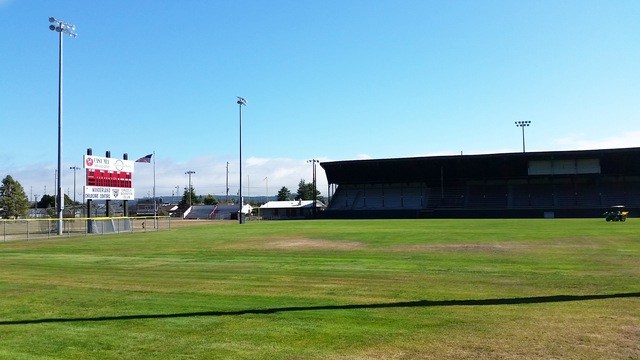Hoquiam Council member Angela Forkum and about a dozen other residents are going to help shape Olympic Stadium’s future by forming a committee to focus on long-term use and upkeep of the facility.
“I want my kids to continue to play there,” Forkum said. “And I want to see it maintained for generations to come.”
The all-wood venue at 28th and Cherry streets has been on the National Register of Historic Places for a decade. It opened in 1938 after the city received a grant for the concept of a wood structure from the Civil Works Administration, the forerunner to the Works Progress Administration. It’s the last stadium built as a result of this program still known to be in operation.
A renovation was completed about 10 years ago. It seats about 7,500 spectators today, but had 10,000 seats when it first opened.
“It’s a beautiful field. The stands are absolutely gorgeous,” Forkum said. “But it’s getting more expensive to keep up the stadium.”
Olympic Stadium is under the control of the city. The Hoquiam School District is a frequent user of the facility that’s home to Grizzly football, girls soccer and other youth sports as well as college baseball.
Forkum said she’s heard people watching games at the stadium say “they really need to maintain this.”
“‘They’ is all of us who pay taxes in the city of Hoquiam,” she explained. “If we want it to last, we have to be active participants in making that happen.”
City Administrator Brian Shay said the group, tentatively named “Friends of the Olympic Stadium,” has a variety of options available.
It could become a non-profit organization devoted to the stadium. Users pay rental fees for time at the stadium but it requires substantial maintenance.
Annual maintenance cost during the 2015-16 Fiscal Year alone was about $120,000. Replacing the fire sprinklers would cost about $150,000 and to paint it about $40,000. The roof was replaced recently at a cost of $400,000, but siding is the next highest job cost needed at the stadium. Shay said the city is amid determining the price of this latest task.
Voters approved $1.5 million bond in 1980 to rehabilitate the stadium. Another such bond is a possibility.
Shay also said forming a taxing district for the stadium is another option. He pointed out that Hoquiam isn’t the only group of users, and that the district could be countywide or regional.
Or the group might end up simply as a “group of citizen volunteers helping to raise funds,” he said.
Annual Loggers Playdays and Easter egg hunts are only a handful of other community events held at the stadium. Forkum said it use to be the site of a blue grass festival but that it’s a good place for performances and other community events.
“We need to start combining forces,” she said.
Forkum pointed to the Lacey-Thurston County Regional Athletic Complex (RAC) as a model. It’s a 67-acre facility formed from a partnership between the city of Lacey and Thurston County.
Hoquiam’s own 7th St. Theatre is another example of a successful organization that might prove inspirational as a non-profit. Like the stadium, it’s on the National Register of Historic Places, Shay said.
Finding a way to access more grant money to maintain the facility is important as Forkum said, “it’s getting more expensive to keep up the stadium.”
Those wanting to help shape the future of the stadium, or are willing to make a donation, can contact Forkum at (360) 480-9038 or Shay at (360) 538-3983.



